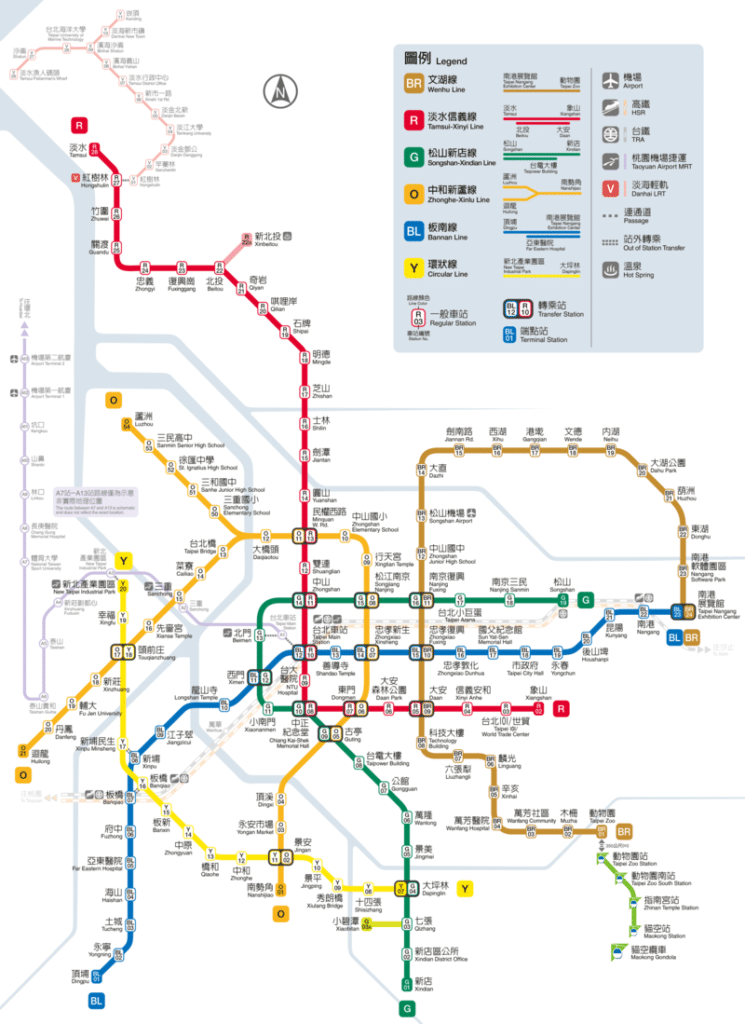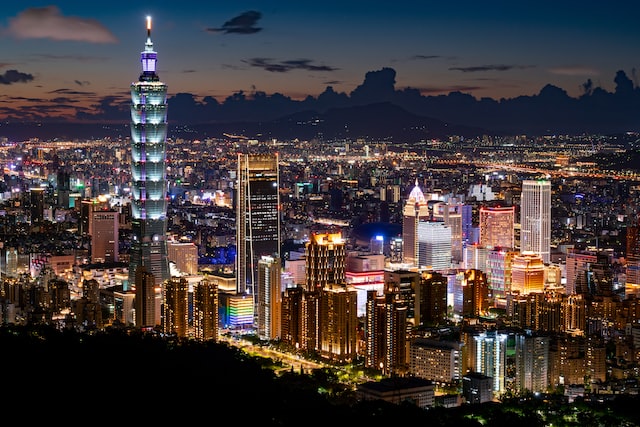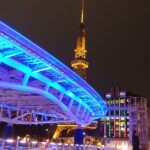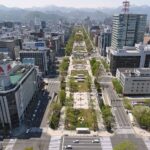In Taipei, there are many different ways to get around the city using public transportation. The Taipei Metro, a rapid transit system with six lines and 131 stops, is the primary mode of public transportation. It is a quick, affordable, and convenient way to move about Taipei. There are also a high-speed rail, the Maokong Gondola, a cable car system, and city buses, which are easy to use and go to a lot of places. Together with scooter rental services, taxi, and Uber services are also offered. With so many options, visitors may get around Taipei quickly and economically.
Basic information about the Metro system in Taipei
One of the world’s most effective public transportation systems is the Taipei subway. It consists of six lines that connect the major centers and residential regions all around the city. Maps can be seen throughout the stations and are clearly marked with lines, which are color-coded. People who ride the Taipei metro can also get discounts, such as lower fares for seniors and students. The metro system is a fantastic way to get around the city quickly and efficiently because it is rapid, safe, and dependable.
The lines of the Taipei subway system
The Taipei Metro is a part of Taiwan’s capital city Taipei’s thriving and effective public transportation system. A rapid transit system serving the city and its surroundings is the Taipei Metro, also referred to as the Taipei Rapid Transit System. One of the largest metro networks in the world, the system comprises of six lines and 131 stops. The primary means of public transportation in the city is the Taipei Metro, which is run by the Taipei Rapid Transit Corporation. It links all of the main tourist sites, shopping centers, administrative buildings, and residential neighborhoods. The Taipei Metro’s six lines are as follows:
BR – Wenhu line (brown) – Nangang Exhib Center–Taipei Zoo
The Wenhu line, also known as the Brown line (code BR), is a metro line in Taipei that is operated by Taipei Metro. This line is named for the neighborhoods of Wenshan and Neihu, which it connects. It is an automated medium-capacity rubber-tired metro line that is 25.1 kilometers (15.6 miles) long and serves a total of 24 stations located in 7 districts around Taipei. Of these stations, 22 are elevated and 2 are underground. The length of the line is 25.1 kilometers (15.6 mi). As of April 2022, the line is responsible for the transportation of around 140,000 passengers on a daily basis, on average.
The Muzha line, which included the Wenshan segment, started operating for paying customers on March 28, 1996. On July 4, 2009, the Neihu sector started providing revenue services. Up until October 8, 2009, the Wenhu line was known by its colloquial name, the Zhahu line, which was a contraction of the name Muzha–Neihu line. This was the first line to be built in Taipei’s metro system, and it is the only line in the system that does not have a train approaching melody.
R – Tamsui–Xinyi line (red) – 28 stations
The Tamsui–Xinyi Line is a metro line in Taipei that is run by Taipei Metro. It is called for the two districts that it connects, namely Tamsui and Xinyi. The line has the designation R. It consists of a total of 28 stations that provide service to the districts of Tamsui, Beitou, Shilin, Datong, Zhongshan, Zhongzheng, Daan, and Xinyi. It is now the Taipei Metro line with the greatest distance, clocking in at 29 kilometers or 18 miles.
The Tamsui segment follows the route of the decommissioned Tamsui railway line for the most part. There, the majority of the lines and stations have been updated, with the exception of the Zhongzheng district, which required the construction of a new tunnel because there was insufficient surface right-of-way available.
The Red line of the metro system is one of the lines with the highest capacity. Xinbeitou station is elevated; the route and stations between and including Yuanshan and Beitou are elevated; the route and stations between and including Fuxinggang and Hongshulin are ground level; and Tamsui station is elevated. The route and stations between and including Fuxinggang and Hongshulin are elevated. The route and stations between and including Fuxinggang and Hongshulin are elevated.
G – Songshan-Xindian line (green) – 19 stations
The Songshan–Xindian or Green line (code G) is a metro line in Taipei that is run by Taipei Metro. It is called after the neighborhoods that it connects, which are Xindian and Songshan. The route of the former Xindian (Hsintien) railway line, which was abandoned in 1965 on the southern portion of its route, is followed by a portion of the current railway line as it passes below Roosevelt Drive.
O – Zhonghe–Xinlu line (orange) – 26 stations
The Zhonghe–Xinlu or Orange line (code O) is a metro line in Taipei that is run by the Taipei Metro and is called after the districts it connects, Zhonghe, Xinzhuang, and Luzhou. The Zhonghe–Xinlu or Orange line also goes by the moniker Orange line. The line begins at Nanshijiao in Zhonghe, travels through the middle of Taipei, and then divides into two separate branches: one leads to Huilong through Xinzhuang, and the other leads to Luzhou.
1998 saw the opening of the southern segment of the highway, which ran from Nanshijiao and Guting. After that, a connection was made with the Tamsui Line. It was determined that there was an immediate demand for a metro line to accommodate the large number of people traveling into and out of the central business district of Taipei from the neighborhoods of Luzhou and Sanchong. [1] At some point in the future, the line will be split into two branches, each of which will connect to Guting via central Taipei. In 2012, the extension was made available in its entirety.
The whole line is buried beneath the ground, with the only exception being the maintenance depot.
BL – Bannan line (blue) – 23 stations
There are a total of 23 stations on the Bannan or Blue line of the Taipei Metro in Taipei, Taiwan. This line serves the districts of Nangang, Xinyi, Daan, Zhongshan, Wanhua, Banqiao, and Tucheng. The Bannan line also goes by the code BL. The name of the line is a portmanteau that combines the words “Banqiao” and “Nangang.”
The entire railroad runs underground. Due to the excavation of tunnels using the cut-and-cover method, there was a significant amount of road traffic that had to be rerouted. Because of this, the line passes beneath the highways that are already there and has a total length of 28.3 kilometers (17.6 mi).
Y – Circular line (yellow) – Dapinglin–New Taipei Industrial Park
Taipei Metro is in charge of the operation of a metro line known as the Circular or Yellow line (code Y). The length of the first phase of the project is roughly 15.4 kilometers (9.6 miles), and it has a total of 14 stations along its route. This section of the project is known as the Dapinglin to New Taipei Industrial Park section. On January 31, 2020, access was granted to this primary portion. Hitachi Rail Italy provided the route with 17 sets of driverless medium-capacity trains consisting of four cars each.
The lines of the Taipei Metro are simple to operate, and it provides a quick and straightforward way to navigate around the city. All stations have ticket sales, and prices vary depending on how far you travel. A fantastic method to discover the city and its attractions is by using the Taipei Metro.
Map of Taipei Metro 2023 – Free Download in PDF

The expansive city of Taipei, Taiwan, may be navigated with the help of the Taipei Metro. You may simply explore the city with the updated Map of Taipei Metro 2023, which is available for free download in PDF format. The new lines and stations that have been added in recent years are included on this map together with all other lines and stations. Also, it provides details on ticket costs and station transfers. You may confidently and easily discover everything Taipei has to offer with the help of this practical and simple-to-use map.
Public transport tickets in Taipei – Best types for travelers & actual prices
The city’s public transportation system is an effective and reasonably priced option for visitors to Taipei to see the city and its surroundings. It’s crucial to become familiar with the many ticket options and their costs, whether you intend to take the Metro, bus, or cab.
Single Journey Tickets, All-Day Passes, and EasyCards are the three primary categories of public transportation tickets available in Taipei. Single-journey tickets are the simplest type of ticket and are bought for one-way trips. They are offered at bus and Metro station ticket machines. All-Day Passes can be bought at ticket machines in Metro stations. They let you use public transportation as much as you want for a whole day. Last but not least, contactless smartcards called EasyCards are useful for frequent users of public transportation. The EasyCard website, ticket machines at Metro stations, and 7-11 convenience stores all sell them.
Single-journey tickets normally range in price from TWD 20 to TWD 65, depending on the mode of transportation and distance traveled. All-Day Passes are TWD150, while EasyCards are TWD100 with a TWD100 minimum load requirement.
It’s necessary to be familiar with Taipei’s public transportation rules and regulations in addition to the ticket types and costs. Before boarding the Metro or a bus, passengers must have a valid ticket, and those tickets must be verified at the ticket machines. Also, it is against the law to consume alcohol, consume food, or smoke while traveling. Additionally, passengers should avoid obstructing aisles or doorways.
Because there are so many different ticket types, prices, and rules, it is usually important to learn about them before taking Taipei’s public transportation. You can guarantee a pleasurable and trouble-free journey by doing this.
Summary of fares for public transport in Taipei
- In Taipei, there are three main types of public transit tickets:
- Single journey tickets – ranges from TWD 20 to TWD 65
- All-day passes – TWD 150
- EasyCards – TWD 100 with a TWD 100 minimum load requirement.
Timetables & Schedules of Taipei Metro system
The Taipei Metro system runs from 6 a.m. to 12 a.m., with peak- and off-hour headways of 3-5 minutes and 8–15 minutes, respectively. Each station’s first train leaves at six in the morning, and its last train leaves at eleven thirty. In terms of frequency of operation, the busiest lines operate more frequently than the less busy lines. To provide more service, the frequency may be increased during busy times and on holidays. For more details, please visit the Taipei Metro website. Weekend and holiday schedules may vary.
What Are Other Options For Public Transportation In Taipei?
In Taipei, Taiwan, public transportation is an essential aspect of daily life. Although the metro is the most popular mode of transportation in the city, there are a variety of different ways to get around if you want to see more of it. Below are a few of the additional Taipei public transit options.
One of Taipei’s most popular modes of public transportation is the bus. Numerous important locations in the city are served by the vast bus network. Bus fares, which range from $15 to $30, are likewise reasonably priced.
The High Speed Rail (HSR), which connects Taipei with cities throughout Taiwan, is the last option. Tickets for the HSR can be ordered in advance online, and it runs quickly and effectively. Both individuals who want to swiftly go around Taipei and those who wish to see other regions of Taiwan should consider using the HSR.
Taxis are a quick and easy way to get around Taipei, and they are easy to find. Taxi stands are located in the city center, and taxis are available at the majority of popular tourist destinations. Although taxi costs are a little more expensive than bus fares, they might be a decent choice for those who need to get somewhere quickly.
A wonderful method to move around Taipei is to use the YouBike bike-sharing program. Users can rent bikes for a few hours or a whole day at YouBike stations that can be found all around the city. The costs are quite affordable, and it’s an excellent way to move around the city and get some fresh air.
These are only a few of Taipei’s public transit alternatives. There is a solution that will work for you whether you want a cheap method to go around the city or a quick way to get outside of Taipei.
How To Get From Taoyuan International Airport (tpe) To The City Center With Public Transport?
If you’re not familiar with the area, getting from the Taoyuan International Airport to the city center can be difficult. Thankfully, you can reach your destination using a variety of public transit choices. This is a guide to the various options and how to use public transit to travel from Taoyuan International Airport to the city core.
Trains are the most practical mode of transportation to get from the airport to the city core. The Taoyuan Airport MRT, Taiwan’s first operational metro system, runs a 35-minute route between the airport and the city center. Depending on the stop you get off at, the train’s fare ranges from NT$30 to NT$50 (US$1 to US$1.60), and it runs every day from 6:00 am to 11:00 pm.
The bus is an additional mode of public transportation. The Airport Express and the City Bus are two of the bus lines that run between the airport and the city’s core. The City Bus needs about two hours, but the Airport Express needs about an hour and a half. Both cost between NT$30 and NT$50 (US$1 and US$1.60).
From the airport, you can also take a taxi to the city’s core. In around 40 minutes, a taxi from the airport can get you where you’re going. The cost will be between NT$1,100 and NT$1,200 (US$35 and US$40), depending on where you are going.
Finally, the airport offers automobile rentals. Depending on the type of vehicle you select, you can rent a car for between NT$2,000 and NT$3,000 (US$65 and US$90) per day from one of the several car rental firms situated near the airport.
There are numerous public transportation choices available to make your trip from the Taoyuan International Airport to the city center as simple as possible. Make your trip to Taiwan as stress-free as you can by keeping these choices in mind the next time you go there.
What kind of sightseeing do you have to see if you visit Taipei for the first time?
Travelers from over the world go to the colorful and interesting city of Taipei, which is the capital of Taiwan. Taipei offers something for everyone with its thriving night markets, top-notch museums, and magnificent temples. Here are some of the greatest sights to see in Taipei, from the National Palace Museum to the lively Shilin Night Market.
- Everyone interested in Chinese history and culture must visit the National Palace Museum. Around 700,000 historical items, including imperial collections from the Ming and Qing dynasties, are on display in this amazing museum. The museum’s numerous galleries offer visitors a chance to look at anything from paintings and calligraphy to jade and bronze objects.
- The landmark Taipei 101 must be seen on any vacation to Taiwan. This technical marvel, the ninth-tallest structure in the world, is also the tallest structure in Taiwan. Guests can either take a stroll through the spectacular skyscraper’s ground level gardens or take the express elevator to the 89th-floor observation deck for expansive views of the city.
- A must-see for any traveler is the crowded Shilin Night Market. This well-known market has a wide range of food, from Taiwanese street food to food from other countries. People can buy everything from souvenirs and clothes to electronics and household goods from the market’s many vendors.
- In Taipei, the Chiang Kai-shek Memorial Hall is another well-liked tourist destination. This large memorial complex is a tribute to Chiang Kai-shek, the former leader of the Republic of China. It has a museum, a memorial hall, and a large bronze statue of Chiang Kai-shek. Regular changing of the guard ceremonies are held in the memorial hall and are a favorite destination for tourists.
- And last, a trip to Taipei wouldn’t be complete without visiting one of the many temples there. People can look around the city at the many religious buildings and be amazed at how complicated they are to build and decorate, from the beautiful Longshan Temple to the majestic Confucius Temple.
Taipei is a city packed with attractions, from renowned museums to active night markets. Taipei has much to offer everyone, whether you want to take in the city’s cultural attractions or indulge in some of its delectable street food.
Summary of our tour guide for Taipei
Taiwan’s capital city, Taipei, is a thriving metropolis. It is renowned for its wonderful culture, mouthwatering cuisine, and first-rate public transit system. Buses, trains, and the MRT, a metro system, make up the public transit network. It takes people to all of the city’s most popular places and is new and efficient. It is also reasonably priced, making it a fantastic choice for both visitors and residents. Thanks to its great public transportation, Taipei is a great city to visit and enjoy.
Top 5 FAQs and answers about Taipei public transport?
- What kinds of public transportation are offered in Taipei?
- The Taipei Metro, buses, taxis, and U-bikes make up Taipei’s public transportation network. The city and its outskirts are served by the Taipei Metro fast transit system. With more than 1.7 million passengers passing through each day, it is one of the busiest metro systems in the world. With over 1,500 routes serving the city and its surrounds, buses are the most popular mode of public transportation in Taipei. Taxis are a practical way to navigate around the city and are generally accessible. Since they are simple to use and can be rented from many places, u-bikes are a well-liked option for quick travels.
- What is the cost of using public transportation?
- The cost of public transportation in Taipei varies depending on the mode and distance. The cost of using the Taipei Metro depends on the distance traveled and ranges from NT$15 to NT$65. From NT$15 to NT$30 is the price range for buses. Taxis impose additional taxes based on the distance traveled in addition to a base rate of NT$70. U-bikes are available for rent for NT$10 per hour.
- What are the public transportation’s operational hours?
- On weekdays, the Taipei Metro is open from 6 am to midnight; on weekends and holidays, it is open from 6 am to 1 am. The bus runs from 6 am until 11 pm. Taxis run around-the-clock. From 6 am to 11 night, U-bikes are available for rent.
- Is there an app that can guide me through Taipei’s public transportation system?
- Sure, you can use a mobile app called EasyCard to get around Taipei’s public transportation system. You may purchase Metro and U-bike tickets through the app, as well as view the prices and schedules for the Taipei Metro, buses, and U-bikes.
- Are there any specials for Taipei’s public transportation?
- Sure, there are discounts offered in Taipei for some forms of public transportation. For instance, discounts on the Taipei Metro and U-bikes are available to students and older people. Discounts are offered for groups of four or more when using buses. Holders of the EasyCard are also eligible for discounts.
Useful links







